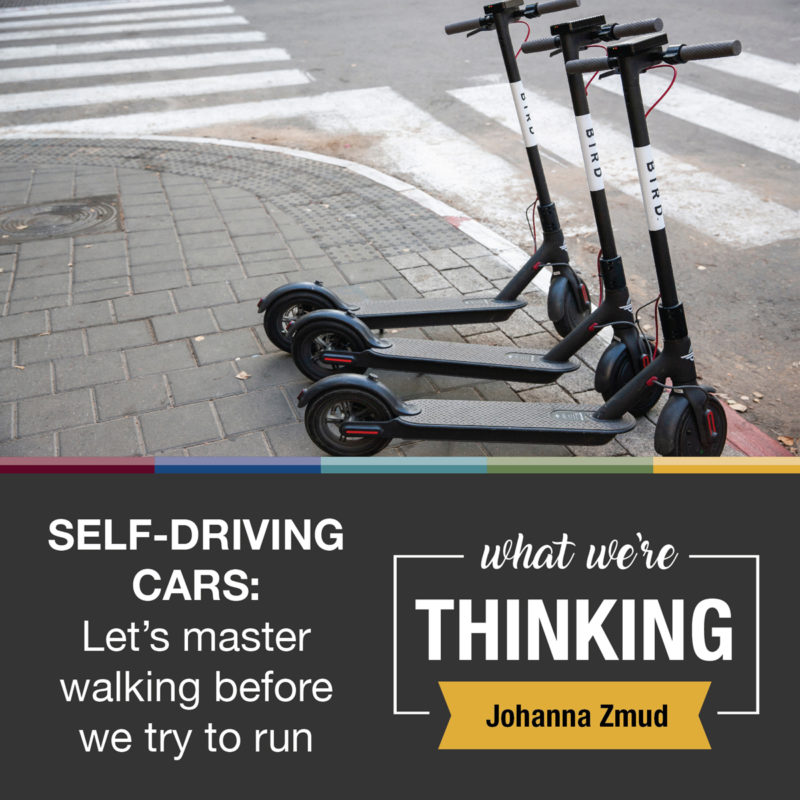 By Johanna Zmud
By Johanna Zmud
Self-driving cars, along with other recent innovations like ride-hailing and electric scooters, are pushing the idea of disruptive mobility into our daily experience. But as business models go, disruption doesn’t always work out so well. Just ask the folks at scooter-sharing company Bird.
In December, the company left an early Holiday surprise in the form of 200 of their sleek electric scooters on the streets of Frisco, Texas (in the dark of night, just like Santa), with no prior announcement or clearance. City officials quickly responded with a lump of coal in Bird’s stocking, ordering the company to remove their zippy rides post haste. When the company ignored that direction, city code enforcement officers were dispatched to pluck the scooters from their unauthorized perches.
Bird company officials clearly didn’t do their homework, didn’t ask the right questions, and the result was a product rollout face plant. The introduction of self-driving autos could suffer similar setbacks if we don’t learn from the interim steps we’re now navigating before actual full automation becomes a reality.
Any mention of autonomous travel in popular media routinely assumes the highest possible levels — true hands-off, read-a-book or take-a-nap automation (referred to in industry standards as level 4 or 5). But lower levels of self-driving assistance (levels 2 and 3) are becoming more common every day, with each new car that rolls off the assembly lines. The problem is, we really don’t understand much about the impacts of level 2 or 3 on the driving environment or the driver.
If we want to ensure success with higher automation levels, we need to start asking the right questions about lower levels first, in which the car can steer, brake and accelerate in certain circumstances (but still requires driver involvement). For instance:
- Are people’s buying decisions influenced by the availability of such features? Do they actually seek out the automation features? Or are they wanting to simply buy a new car and accepting whatever features come along with it, whether desired or not?
- Do some potential new car buyers only reluctantly accept the whiz-bang features or openly avoid them when possible? Do they not place high value on the features, or do they not trust that they will work?
- What about rental car experiences? Do customers (typically on tight schedules) actually take time to read relevant owner’s manual sections that describe automation features? Do rental car sales associates provide any brief education on how the features work? Do customers ask the sales associate how to turn the features off? What’s the overall customer satisfaction experience with these features, whether for first-time users or repeat customers?
- What are the implications of autonomy features having different names depending on the auto manufacturer’s marketing scheme? What’s the difference between Traffic Jam Assist, Super Cruise, Autopilot, and Pilot Assist (apart from the logo on the hood)?
These and other questions deserve careful consideration. Through research we’re conducting at the Texas A&M Transportation Institute, we’re searching for the answers. What we learn will help to inform decisions — from both consumer acceptance and public policy angles — as both the industry and government regulators move ahead.
In this age of disruption, regardless of mode, we can expect things to be messy, which brings us back to the scooter example.
Scooter defenders point to them being a viable solution to urban mobility problems, particularly as a “last mile” connection between public transit hubs and a traveler’s final destination, along with their convenience and non-polluting nature. Detractors cite safety concerns and injury frequency, along with the cluttering of street corners and sidewalks with unwelcome devices that become pedestrian hazards.
When both sides are right, as is the case here, the best path forward calls for meaningful discussion built upon finding answers to the right questions at every stage of deployment — whether for scooters or autonomous cars.
In the quest to realize most any advancement in technology, the natural tendency is to step on the gas and race forward. Where self-driving cars are concerned, however, it would be wiser at this point to downshift the discussion.
We should remember what we learned when we were very young. You have to walk before you can run.
Johanna Zmud is a senior research scientist at the Texas A&M Transportation Institute.
This article was originally published in the The Hill, February 2, 2019.